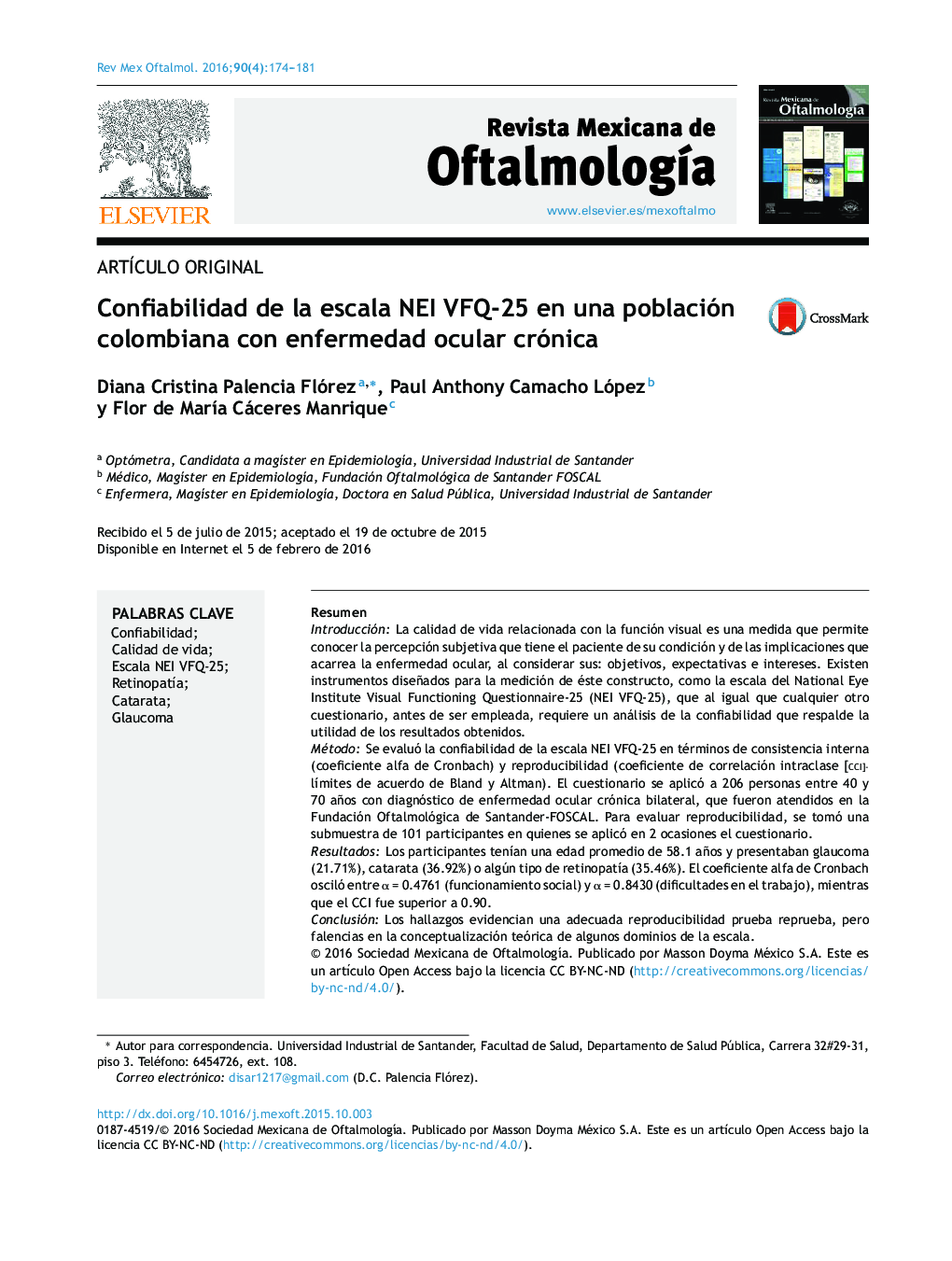| Article ID | Journal | Published Year | Pages | File Type |
|---|---|---|---|---|
| 4032242 | Revista Mexicana de Oftalmología | 2016 | 8 Pages |
ResumenIntroducciónLa calidad de vida relacionada con la función visual es una medida que permite conocer la percepción subjetiva que tiene el paciente de su condición y de las implicaciones que acarrea la enfermedad ocular, al considerar sus: objetivos, expectativas e intereses. Existen instrumentos diseñados para la medición de éste constructo, como la escala del National Eye Institute Visual Functioning Questionnaire-25 (NEI VFQ-25), que al igual que cualquier otro cuestionario, antes de ser empleada, requiere un análisis de la confiabilidad que respalde la utilidad de los resultados obtenidos.MétodoSe evaluó la confiabilidad de la escala NEI VFQ-25 en términos de consistencia interna (coeficiente alfa de Cronbach) y reproducibilidad (coeficiente de correlación intraclase [CCI]-límites de acuerdo de Bland y Altman). El cuestionario se aplicó a 206 personas entre 40 y 70 años con diagnóstico de enfermedad ocular crónica bilateral, que fueron atendidos en la Fundación Oftalmológica de Santander-FOSCAL. Para evaluar reproducibilidad, se tomó una submuestra de 101 participantes en quienes se aplicó en 2 ocasiones el cuestionario.ResultadosLos participantes tenían una edad promedio de 58.1 años y presentaban glaucoma (21.71%), catarata (36.92%) o algún tipo de retinopatía (35.46%). El coeficiente alfa de Cronbach osciló entre α = 0.4761 (funcionamiento social) y α = 0.8430 (dificultades en el trabajo), mientras que el CCI fue superior a 0.90.ConclusiónLos hallazgos evidencian una adecuada reproducibilidad prueba reprueba, pero falencias en la conceptualización teórica de algunos dominios de la escala.
IntroductionThe Quality of life related of visual Functioning, is a measure that reflect the subject perception the patient has of his condition and the implications that carries of ocular disease, if consider: objective, expectations and interests. There are instruments designed to measure this construct, as the scale of National Eye Institute Visual Functioning Questionnaire -25 (NEI VFQ-25), that like any other questionnaire, before being used, it requires an analysis of reliability that supports the usefulness of the results.MethodsThe reliability of the Scale NEI VFQ-25 was evaluated in terms of internal consistency (Cronbach's Alpha coefficient) and reproducibility (Intraclass Correlation Coefficient–Limits of agreement of Bland and Altman). The questionnaire was applied in 206 people between 40 and 70 years old with diagnostics of bilateral chronic eye disease, who they were treated in the Fundación Oftalmológica de Santander FOSCAL. To assess reproducibility a subsample of 101 people were employed in whom it was applied twice the questionnaire.ResultsThe participants has an average age of 58.1 years and had glaucoma (21.71%), cataract (36.92%) or some form of retinopathy (35.46%). The Cronbach's Alpha coefficient ranged from α= 0.4761 (social Functioning) and α= 0.8430 (difficulties at work), while the Intraclass correlation coefficient was higher than 0.90.ConclusionThe findings demonstrate adequate reproducibility test fails, but shortcomings in the theoretical conceptualization of some domains of the scale.
